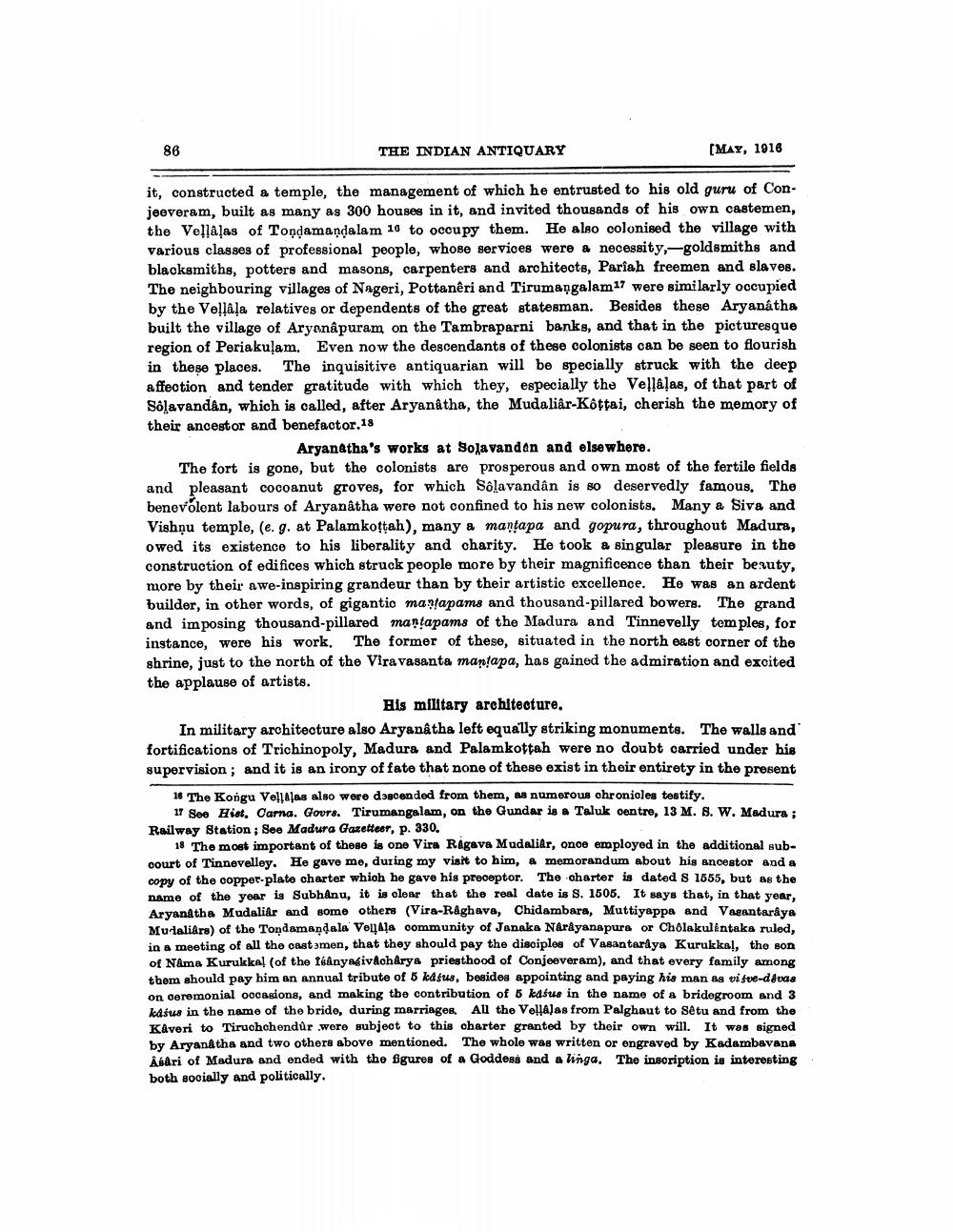________________
86 THE INDIAN ANTIQUARY
(MAY, 1916 - it, constructed a temple, the management of which he entrusted to his old guru of Conjeeveram, built as many as 300 houses in it, and invited thousands of his own castemen, the Vel?aļas of Tondamandalam 10 to occupy them. He also colonised the village with Various classes of professional people, whose services were a necessity,-goldsmiths and blacksmiths, potters and masons, carpenters and architects, Pariah freemen and slaves. The neighbouring villages of Nageri, Pottanêri and Tirumangalam 17 were similarly occupied by the Veļļala relatives or dependents of the great statesman. Besides these Aryanatha built the village of Aryanapuram on the Tambraparni banks, and that in the picturesque region of Periakuļam. Even now the descendants of these colonists can be seen to flourish in these places. The inquisitive antiquarian will be specially struck with the deep affection and tender gratitude with which they, especially the Vellalas, of that part of Sõlavandân, which is called, after Aryanatha, the Mudaliâr-Kottai, cherish the memory of their ancestor and benefactor. 18
Aryanatha's works at Solavandon and elsewhere. The fort is gone, but the colonists are prosperous and own most of the fertile fields and pleasant cocoanut groves, for which Sôlavandân is so deservedly famous. The benevolont labours of Aryanatha were not confined to his new colonists. Many a Siva and Vishņu temple, (e. g. at Palamkottah), many a mantapa and gopura, throughout Madura, owed its existence to his liberality and charity. He took a singular pleasure in the construction of edifices which struck people more by their magnificence than their beauty, more by their awe-inspiring grandeur than by their artistic excellence. He was an ardent builder, in other words, of gigantic manlapams and thousand-pillared bowers. The grand and imposing thousand-pillared mantapams of the Madura and Tinnevelly temples, for instance, were his work. The former of these, situated in the north east corner of the shrine, just to the north of the Viravasanta mantapa, has gained the admiration and excited the applause of artists.
His military architecture. In military architecture also Aryanatha left equally striking monuments. The walls and fortifications of Trichinopoly, Madura and Palamkottah were no doubt carried under his supervision; and it is an irony of fate that none of these exist in their entirety in the present
16 The Kongu Vellalas also wore dagcended from them, as numerous chronicles testify.
1T See Hist, Carna. Gours. Tirumangalam, on the Gundar is a Taluk oentre, 13 M. 8. W. Madura ; Railway Station ; See Madura Gazetteot, p. 330.
18 The most important of these is one Vira Ragava Mudaliar, once employed in the additional subcourt of Tinnovelley. He gave me, during my visit to him, a memorandum about his ancestor and a copy of the copper-plate charter which he gave his preceptor. The charter is dated S 1555, but as the name of the year is Subhanu, it is clear that the real date is S. 1505. It says that, in that year, Aryanatha Mudaliar and some others (Vira-Raghava, Chidambara, Muttiyappa and Vacantaraya Mulaliars) of the Tondamandala Vella community of Janaka Narayanapura or Cholakulintaka rulod, in a meeting of all the onstsmen, that they should pay the disciples of Vasantaraya Kurukkal, the son of Nama Kurukkal (of the fAnyagivAchArya priesthood of Conjeeveram), and that every family among them should pay him an annual tribute of 5 kafus, besides appointing and paying his man as visue-devas on ceremonial occasions, and making the contribution of 6 kasus in the name of a bridegroom and 3 kasus in the name of the brido, during marriages. All the VollAlas from Palghaut to sētu and from the Kaveri to Tiruchchendur .were subject to this charter granted by their own will. It was signed by Aryanatha and two others above mentioned. The whole was written or engraved by Kadambavana Abari of Madura and ended with the figures of a Goddess and a linga. The inscription is interesting both socially and politically.




